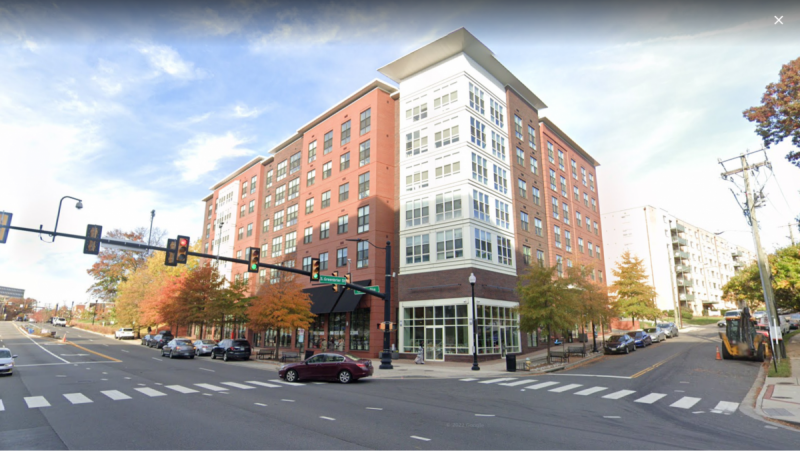Arlington isn’t full

Five stories of apartments above commerce in Arlington, VA. Image by Google Street View.
Arlington is known for desirable schools, lots of places to eat and hang out, four Metro lines, and a ton of good jobs – but the county has become wildly unaffordable due to restrictive zoning. If you changed that, a lot more people could live there and enjoy those things. Like, a lot!
According to my calculations, if Arlington allowed five stories of apartments above commerce by right in all of what are now “one family dwelling districts” in the county zoning database, the county could accommodate as many as 900,000 new residents in 545 million square feet of residential living space.
Let’s go to the maps
Arlington is a well-connected part of the DC metro area. A 2022 report notes that “Arlington has more private office space than the Central Business Districts of Los Angeles, Denver, Dallas and Seattle, and Downtown Atlanta.” And according to CommuteTimeMap.com, the vast majority of its land area is less than 30 minutes by transit from a major job center like downtown DC, Rosslyn, Crystal City, and Ballston.
All areas of Arlington that are within a 30-minute transit commute of either Metro Center, Rosslyn, or Pentagon City. Created with CommuteTimeMap.com. 
Unfortunately, much of its buildable land is reserved exclusively for single-family detached homes. How much? According to my analysis of the REA Property Polygons and Zoning Polygons in the Arlington County GIS database, about 11.4 square miles of land falls within the R-6, R-8, R-10, and R-20 “one family dwelling districts” - 44% of Arlington’s entire land area! When we exclude large institutional parcels and right-of-way, the one-family dwelling districts contain 8.1 square miles of privately owned residential parcels - land that would be buildable if not for zoning laws. That’s more than eight times the size of Arlington National Cemetery!
All parcels in Arlington that are greater than 800 square feet and less than one acre in size, and that are zoned exclusively for single family detached homes. Map created in QGIS with data from Arlington County GIS (here and here). 
Let’s imagine that 10% of this land (521 acres) is purchased by the county for new parks, and the other 90% is rezoned to allow up to five stories of residential construction on top of an optional commercial layer. How much new housing could be built on this land?
A rather attractive five-over-one apartment building under construction on Columbia Pike. Image by Google Street View. 
This small-lot apartment building near Rosslyn is four stories, not five, but it is so cute that I had to include it. Image by Google Street View. 
Let’s assume that the new buildings cover two-thirds of their lot and have a floor plate efficiency of 80%. That means that 80% of their floor area is actual “living space”, while the rest is dedicated to stairs, elevators, hallways, and maintenance spaces. Thus, if Arlington’s one-family dwelling districts were rezoned to allow five stories of apartments, landowners could build about 545 million square feet of living space. According to RentCafé, the average American apartment has 526 square feet per occupant. If each new Arlingtonian occupies an average of 526 square feet of living space, then this upzoning would allow enough floor space for about 1 million people.
How many new residents would this be? Arlington contains about 26,000 parcels zoned exclusively for detached single-family homes. Assuming one house per lot and about 3 people per house, the current population of these parcels is at most 100,000. Thus, allowing five stories of housing on these parcels could likely accommodate 900,000 more people.
How many new dwelling units would this be?
That’s hard to answer. A complete neighborhood needs a diversity of dwelling sizes and types to suit all sorts of people, from young singles to large families to people in care facilities. If the new units are 2500 square feet - the average for new single-family homes in 2021 according to the US Census Bureau - then this upzoning would allow for 191,000 new family-sized units. If the new units are the size of the average Arlington apartment today (862 square feet in 2022, according to RentCafé), then this upzoning would allow for 632,000 moderately sized units (replacing the 26,000 large units).
It’s important to note that this analysis has only looked at housing. A full neighborhood also needs a vibrant range of commerce and employment opportunities, such as retail, restaurants, and offices. If one story of commercial construction were permitted below the five stories of residential (six stories total), that would allow for 46 million square feet of new commercial space.
Arlington has plenty of room for new housing
High housing prices are a policy choice. Considering that 71% of Arlington’s housing units are already in multifamily buildings, and that a majority of Arlingtonians already live in high-density Planning Corridors, would upzoning the rest of the county really be that radical? Surely it is no more radical than reserving 5210 acres of prime real estate for a privileged few.
